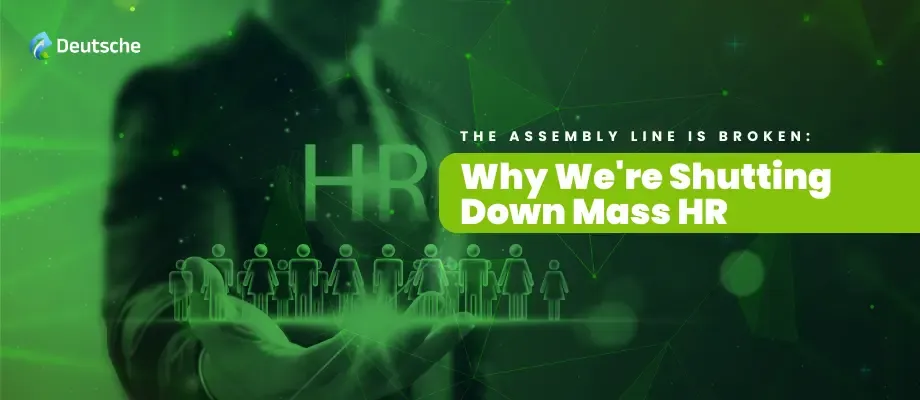For decades, the prevailing operating model in Human Resources has been one of mass production. We hired in cohorts, trained in classrooms, and managed through standardized policies. We spoke of our "most valuable asset" while designing systems that treated people like interchangeable parts. This model, rooted in the industrial age, is fundamentally broken for the human-centric reality of today's world.
I speak with countless leaders who lament the struggle to attract top talent, the quiet persistence of disengagement, and the staggering cost of constant turnover. We’ve tried to solve these challenges with superficial perks and incremental changes, only to find ourselves facing the same core issue: we are applying a one-size-fits-all solution to a universe of unique individuals.
The future—the necessary, urgent future—lies in a complete paradigm shift. We must move from Mass HR to Micro HR.
The End of the Assembly Line
Mass HR was built for scale and control. It was efficient in a world where compliance was the primary goal. But its legacy is a system that often frustrates high performers, overlooks potential, and creates a profound sense of anonymity for the individual. When an employee’s entire career journey is forced into a pre-defined box, is it any wonder they feel like a cog in a machine?
This isn't an HR problem; it's a strategic business liability. In the modern economy, our competitive advantage is directly tied to the creativity, commitment, and problem-solving capabilities of our people. You cannot standardize genius. You cannot mandate passion.
Micro HR is the antidote. It is an operating model that dismantles the assembly line and replaces it with a dynamic, responsive ecosystem. Its core principle is radical respect for the individual, enabled by technology not for surveillance, but for understanding.
The Three Pillars of the Micro HR Model
This shift is not about adding another app to our stack. It’s a fundamental re-imagining of the employer-employee relationship, built on three core pillars.
1. From Job Descriptions to Dynamic Contributions.
We have all seen the brilliant marketer who is also a gifted data analyst, or the software engineer with a knack for client empathy. Traditional, rigid job descriptions wall off these adjacent talents. Micro HR embraces them. It involves creating internal talent marketplaces where projects, mentorship roles, and innovation challenges are staffed based on skills and interests, not just titles. This isn't about creating chaos; it's about unlocking latent potential and creating a more resilient, agile organization. It’s about seeing people for the sum of their capabilities, not just the narrow function they were hired to perform.
2. From Generic Training to Individual Growth Journeys.
The annual, mandatory training module is a symbol of the Mass HR era. It assumes everyone is starting from the same place and needs the same information. Micro HR flips this on its head. It leverages data on an individual's current skills, career aspirations, and even learning style to curate a unique growth pathway. Imagine one employee accessing a nano-learning module on strategic negotiation via their phone during their commute, while another is sponsored for an advanced certification based on their five-year career map. This is no longer a futuristic fantasy; it’s a necessary condition for retaining ambitious talent.
3. From Standardized Benefits to Personal Wellness Portfolios.
Offering the same health plan and vacation policy to a 22-year-old new graduate and a 50-year-old parent with aging dependents is no longer a mark of fairness, but of indifference. Micro HR recognizes that wellbeing is personal. It means providing flexible benefits allowances that can be allocated toward mental health support, financial planning, childcare subsidies, or fitness membersaries based on individual and familial needs. This communicates a powerful message: "We see you as a whole person, with a life outside this office that we respect and want to support."
The Leader's Mandate: Courage Over Convenience
Adopting a Micro HR model is not a simple task. It requires courage. It demands that we, as leaders, relinquish the false comfort of uniformity for the more complex, more rewarding pursuit of individuality. It requires investment in platforms that provide integrative data, not just isolated functions. Most importantly, it requires a deep cultural commitment from the C-suite down.
We must empower our managers to be coaches and curators of talent, not just administrators of policy. We must champion a culture of trust, where personalized work arrangements are the default, not the exception. And we must be transparent about the data we use, ensuring that every piece of technology serves to empower the employee, not to police them.
The era of Mass HR is over. It is being replaced by the Human Era—an era where the companies that thrive will be those brave enough to build organizations around the unique needs and extraordinary potential of every single person they employ. The question is no longer if we should make this shift, but how quickly we can begin.
